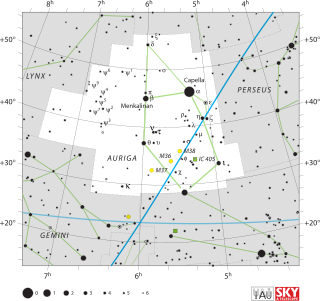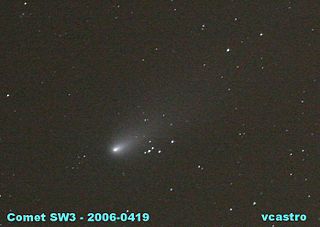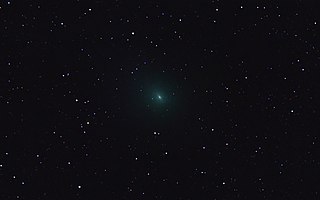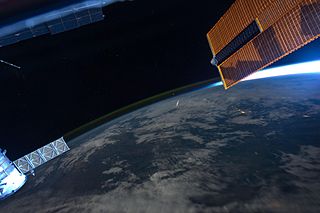Year 82 BC was a year of the pre-Julian Roman calendar. At the time it was known as the Year of the Consulship of Marius and Carbo. The denomination 82 BC for this year has been used since the early medieval period, when the Anno Domini calendar era became the prevalent method in Europe for naming years.

A meteor shower is a celestial event in which a number of meteors are observed to radiate, or originate, from one point in the night sky. These meteors are caused by streams of cosmic debris called meteoroids entering Earth's atmosphere at extremely high speeds on parallel trajectories. Most meteors are smaller than a grain of sand, so almost all of them disintegrate and never hit the Earth's surface. Very intense or unusual meteor showers are known as meteor outbursts and meteor storms, which produce at least 1,000 meteors an hour, most notably from the Leonids. The Meteor Data Centre lists over 900 suspected meteor showers of which about 100 are well established. Several organizations point to viewing opportunities on the Internet. NASA maintains a daily map of active meteor showers.

Auriga is a constellation in the northern celestial hemisphere. It is one of the 88 modern constellations; it was among the 48 constellations listed by the 2nd-century astronomer Ptolemy. Its name is Latin for '(the) charioteer', associating it with various mythological beings, including Erichthonius and Myrtilus. Auriga is most prominent during winter evenings in the northern Hemisphere, as are five other constellations that have stars in the Winter Hexagon asterism. Because of its northern declination, Auriga is only visible in its entirety as far south as -34°; for observers farther south it lies partially or fully below the horizon. A large constellation, with an area of 657 square degrees, it is half the size of the largest, Hydra.

12P/Pons–Brooks is a periodic comet with an orbital period of 71 years. It fits the classical definition of a Halley-type comet with, and is also one of the brightest known periodic comets, reaching an absolute visual magnitude ~5 in its approach to perihelion. Comet Pons-Brooks was discovered at Marseilles Observatory in July 1812 by Jean-Louis Pons, and then later recovered in 1883 by William Robert Brooks.

Comet Machholz, formally designated C/2004 Q2, is a long-period comet discovered by Donald Machholz on August 27, 2004. It reached naked eye brightness in January 2005. Unusual for such a relatively bright comet, its perihelion was farther from the Sun than the Earth's orbit.

Comet Pereyra was a bright comet which appeared in 1963. It was a member of the Kreutz Sungrazers, a group of comets which pass extremely close to the Sun.
The Southern Delta Aquariids are a meteor shower visible from mid July to mid August each year with peak activity on 28 or 29 July. The Comet of origin is not known with certainty. Suspected candidate is Comet 96P Machholz. Earlier, it was thought to have originated from the Marsden and Kracht Sungrazing comets.

8P/Tuttle is a periodic comet with a 13.6-year orbit. It fits the classical definition of a Jupiter-family comet with an orbital period of less than 20 years, but does not fit the modern definition of. Its last perihelion passage was 27 August 2021 when it had a solar elongation of 26 degrees at approximately apparent magnitude 9. Two weeks later, on September 12, 2021, it was about 1.8 AU (270 million km) from Earth which is about as far from Earth as the comet can get when the comet is near perihelion.

73P/Schwassmann–Wachmann, also known as Schwassmann–Wachmann 3 or SW3 for short, is a periodic comet that has a 5.4 year orbital period and that has been actively disintegrating since 1995. When it came to perihelion in March 2017, fragment 73P-BT was separating from the main fragment 73P-C. Fragments 73P-BU and 73P-BV were detected in July 2022. The main comet came to perihelion on 25 August 2022, when the comet was 0.97 AU from the Sun and 1 AU from Earth. It will be less than 80 degrees from the Sun from 25 May 2022 until August 2023. On 3 April 2025 it will make a modest approach of 0.3 AU to Jupiter. 73P will next come to perihelion on 23 December 2027 when it will be 0.92 AU from the Sun and on the far side of the Sun 1.9 AU from Earth.

C/1680 V1, also called the Great Comet of 1680, Kirch's Comet, and Newton's Comet, was the first comet discovered by telescope. It was discovered by Gottfried Kirch and was one of the brightest comets of the seventeenth century.

Petrus Matheus Marie (Peter) Jenniskens is a Dutch-American astronomer and a senior research scientist at the Carl Sagan Center of the SETI Institute and at NASA Ames Research Center. He is an expert on meteor showers, and wrote the book Meteor Showers and their Parent Comets published in 2006. He is president of Commission 22 of the International Astronomical Union (2012-2015) and was chair of the Working Group on Meteor Shower Nomenclature (2006–2012) after it was first established. Asteroid 42981 Jenniskens is named in his honor.
Comet C/1861 G1 (Thatcher) is a long-period comet with roughly a 422-year orbit that is expected to return around 2283. It was discovered by A. E. Thatcher. It is responsible for the April Lyrid meteor shower. Carl Wilhelm Baeker also independently found this comet. The comet passed about 0.335 AU from the Earth on 1861-May-05 and last came to perihelion on 1861-Jun-03.

45P/Honda–Mrkos–Pajdušáková is a short-period comet discovered by Minoru Honda December 3, 1948. It is named after Minoru Honda, Antonín Mrkos, and Ľudmila Pajdušáková. The object revolves around the Sun on an elliptical orbit with a period of 5.25 years. The nucleus is 1.3 kilometers in diameter. On August 19 and 20, 2011, it became the fifteenth comet detected by ground radar telescope.

Comet Swift–Tuttle is a large periodic comet with a 1995 (osculating) orbital period of 133 years that is in a 1:11 orbital resonance with Jupiter. It fits the classical definition of a Halley-type comet, which has an orbital period between 20 and 200 years. The comet was independently discovered by Lewis Swift on July 16, 1862 and by Horace Parnell Tuttle on July 19, 1862.

Comet ISON, formally known as C/2012 S1, was a sungrazing comet from the Oort cloud which was discovered on 21 September 2012 by Vitaly Nevsky and Artyom Novichonok.

C/2013 A1 is an Oort cloud comet discovered on 3 January 2013 by Robert H. McNaught at Siding Spring Observatory using the 0.5-meter (20 in) Uppsala Southern Schmidt Telescope.

C/2017 K2 (PanSTARRS) is an Oort cloud comet with an inbound hyperbolic orbit, discovered in May 2017 at a distance beyond the orbit of Saturn when it was 16 AU (2.4 billion km) from the Sun. Precovery images from 2013 were located by July. It had been in the constellation of Draco from July 2007 until August 2020. As of June 2022, the 3-sigma uncertainty in the current distance of the comet from the Sun is ±6000 km.

C/2019 U6 (Lemmon), or Comet Lemmon is a long period comet with a near-parabolic orbit discovered by the Mount Lemmon Survey on October 31, 2019. It made its closest approach to the Sun on June 18, 2020. In June 2020 it was visible near the naked eye limit at an apparent magnitude of 6.0. It is the 3rd brightest naked eye comet of 2020 after C/2020 F3 (NEOWISE) and C/2020 F8 (SWAN). It remained visible near the naked eye limit in June.

CAMS is a NASA-sponsored international project that tracks and triangulates meteors during night-time video surveillance in order to map and monitor meteor showers. Data processing is housed at the Carl Sagan Center of the SETI Institute in California, USA. Goal of CAMS is to validate the International Astronomical Union's Working List of Meteor Showers, discover new meteor showers, and predict future meteor showers.

C/2023 P1 (Nishimura) is a long-period comet discovered by Hideo Nishimura on 12 August 2023. With an observation arc of seven months, the outbound orbital period of the comet is estimated to be about 406 years. An eccentricity of 0.996 gives the comet a semi-major axis of about 57 AU, which is comparable to the average distance of Eris at 68 AU. The comet will not leave the Solar System, will come to aphelion in 2227, and return around the year 2430.


















